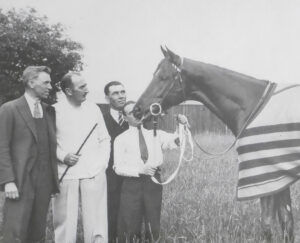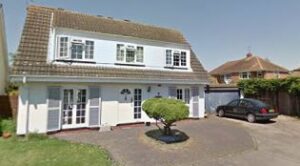We are always pleased to hear from anyone with a Lillington reminiscence, long or short, to contribute to this page. Please contact Margaret Rushton.
Lillington Memories
Topper
Sydney McGregor’s Dog
Andrew McGregor
Lillington Brownies
Upstairs in the Parish Room
In the 1950s the Brownies met in the upstairs room over the parish room (now 1 – 3 Old School Mews, where the dormers are in the picture), which was next door to the Infants School. It was part of the Headmistress’s office and had a rather less than clean floor for the Brownies to sit on.
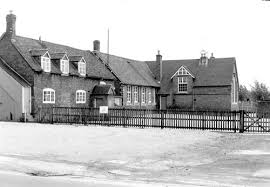
I was brought up in Keith Road. My dad was a Police Officer so the house was classed as a police house. I remember we played in the street and had a great time making slides down Melton Road in the winter. There were fields at the bottom of Melton Road, – that’s where Lime Avenue ended.
I went to Milverton School as an Infant, and used to go by school bus which I caught at the top of Lime Avenue outside a greengrocer’s that I think was called “King’s”.
I used to love going shopping for my mum to Sensicles, a little supermarket at the corner of Lime Avenue and Cubbington Road. Just down Lime Avenue (on the same side) was a little tiny shop that sold knitting wool and haberdashery. I remember my mum buying me a bonnet there, to keep my ears warm.
Jane Knifton
Origin of Lillington Library
Lillington Men’s Club and the Library
After the club moved out, the old school room was converted for use as a parish room in November, 1922.
Two hundred old books found locked in a cupboard were made available by the club as a lending library in the new club. The borough librarian, Mr Ewar, added a further hundred, sixty fiction and forty non fiction, to be changed every two months. The library was later transferred to the Board Room in Pound Lane as a branch library, while Lillington was still ‘the Village’ (from a letter by Gerald Thompson to the Leamington Spa Courier 30th September, 1949). (3)
Growing Up in Lillington
Lillington in the 1940’s & 50’s
On April 26, 1948 at the age of 10½, I moved to Leamington with my parents, sister and grandmother from Worcester. My father had gained promotion in the Fire Brigade along with George Cooper, Graham Cooper’s father. Dad went to Cartwright’s Estate Agents in Regent Street where Mr Metherall was selling his house in Braemar Road. He gave dad the keys to view and that was the beginning of our story.
It was not long after the war and very few people had a telephone, but dad had to have one because of his work in the Fire Service. We had a telegraph pole in our garden with wires coming over from Highland Road and the GPO paid dad rental for having it there. We also had a concrete air raid shelter in the garden which had been built by Mrs Light, the first owner of the house.
There was a grass verge all round Braemar Road, and when dad was Duty Officer, he had to bring the Fire Brigade van home. This meant that the kerb outside the house had to be dropped to get the van off the road. I remember that it cost £12 10 shillings.
At the top of the road there were fields belonging to Mr [Edward] McGregor and there was also a waste area where local boys who called themselves “Lillington Cyclones” made a grass track and used to have competitions with other local boys. My mum was a qualified seamstress and she made them a flag. At the bottom of the road it was still farm fields, leading across to the Leicester Lane houses. There was a pond halfway down where we used to play and collect frogspawn.
I went to Lillington School from April to July 1948 and while I was there we won a country dance festival. Miss Luggar, the teacher, was so proud. I went to Miss Waddon’s dancing school at the old school and I joined the guides in Robin Patrol. I was taught to play the piano by Miss Kibbler in Manor Road and was confirmed by Father Carter at St Mary Magdalene’s Church. It was very high church in those days and we all used to sneeze at the incense.
The nearest bus stop to our house was at the top of Highland Road. It cost 4d to Warwick Street, or we could walk down to the “Fare Stage” stop opposite Lime Avenue and that cost three pence ha’penny.
Mr Hume had a post office counter in the shop on the corner of Lime Avenue and Cubbington Road which is now a wine shop, and Mr & Mrs Faulkner had the shop opposite where the carpet shop is now. Later on, until Crown Way was built, the post office was run by Mr & Mrs Griffin in a tin hut across the road. There were little cottages in front of the old school where there is now a car park. Mr Golby who had a market garden down Cubbington Road on the right, also had a small shop in the front room of the house just below Mr Aitkins the chemist, and there was also a little unit making crisps: I can still smell and taste the grease (horrible!) The Grange, further down Cubbington Road was demolished to build Pine Court.
Dad bought a plot in what had been the orchard of the Grange and had a house built. When my late husband Peter and I married in 1958 we bought Braemar Road from dad so I have many very happy memories of it, even when mum and dad invited Peter to meet them and watch the coronation on television! Our three children were born here and I would like to think that this is where I will end my days.
When the Bomb Dropped
Where the car park is now in front of Old School Mews, there were cottages and a Mrs Shepherd lived there. Tesco’s, on the old Walnut Tree site, used to be a large ivy-covered house where the Proctor family lived.
There used to be interesting photographs of old Lillington in the Lillington Club on Lime Avenue.
When the landmine fell on two houses in Kinross Road [14th November, 1940], we sheltered under the table in Highland Road.
Beyond Braemar Road was just farmland. We used to go on nature walks from school with Miss Luggar, picking rosehips to make into rosehip syrup. Mr Cuthbert ran the Sunday School at Saint Mary Magdalene’s in the late 1940s.
Pam Crump
(5)
Buckley Road
At the top of Wellington Road at the roundabout where the bus stop is now, there used to be a wooden hut which sold sweets cigarettes and groceries. I believe all the prefabs were built as temporary accommodation after the war. I think a businessman bought them at £100 each and moved them to a seaside resort.
DN Price
Wedding Day
Keep Calm & Carry On
Viv Owen
The Second New House
Before felt was laid under roof tiles, cement pointing was applied to the battens and when the bomb fell in Kinross Road a lot of it was shaken down in the blast, and the ceiling of the larger back bedroom was also damaged. When the houses were first built, the water pressure was very low, so each house had a very large storage tank in the roof space, about 6 x 3 x 3 feet.
The McGregor’s Stud Farm House was at the end of Epsom Road. I believe that the McGregors owned most of the Lillington land, hence the Scottish names: Highland, Lonsdale, Kinross, etc.
Kit Smith
Schooldays in Lillington

Room at the Top
Coventry, Edinburgh & Lillington
Although as a youngster my mother had occasionally taken my sister and me on the Midland Red Bus from our home town of Coventry to Leamington Spa to visit the Jephson Gardens, I had never heard of Lillington until one day my father suddenly read out aloud, from the Coventry Evening Telegraph, that an amazingly high block of flats had been opened called Eden Court.
As a young lad I had regularly climbed up the steps of Coventry Cathedral spire and loved heights. So when I read the article, which I believe said you could see up to five counties from the top of Eden Court, I thought ‘wouldn’t it be marvellous to go to the top and get the view’ knowing I would never have the opportunity to do so. Little did I know what the future would be.
Surprisingly, a short time after I made my first visit to Lillington when my father took me on the back of my brother’s motorbike to Buckley Road, Lillington, where he bought a car for the grand sum of £4 10s 0d. From there I was able to see Eden Court. The car was a 1933 Lanchester 10 four-door open tourer, and once he got it back in Coventry, although I was still under the age to drive, I would drive it with a school friend up and down the back entry of our road in Stoke. It was a lovely car with a bright yellow body, black wings and running boards, of course pre-selector gearbox and a very flat battery so we had to use the starting handle. Annoyingly, before I was able to drive it legally (with ’L‘ plates), my father sold it for £25 and two days later my brother saw it at a garage in Ansty for £95 – if only I had that car today.
From school I went to Edinburgh University, but unfortunately dropped out after two years, partly because I more enjoyed my love of heights, climbing Arthur’s Seat and local Munros, rather than swotting academic subjects. I needed to earn some money and got a job as a van driver in Leith for Radio Rentals, taken on because I had A-Level Physics and would be a suitable employee to be trained to repair the latest type of television – the colour set. I was sent to Pendleton in Manchester on the Company’s training course which was brilliant compared with University. I wasn’t keen to go back to Edinburgh and asked if I could be sent down to the Midlands to be near my family and old school friends. They sent me to this place called Leamington Spa – it could not have been better.
I was a Field Service Engineer and they gave me the area between Leamington and Coventry which mainly included Lillington and Kenilworth and then the outlying villages.
I will always remember visiting customers in the Lillington prefabs and how happy they were in the prefabs, but they knew their days were numbered and they might have to move into – yes – Eden Court (which they were not very happy about). Well, we did have quite a few customers in Eden Court, so at last I was able to go up the tower and peer out of the windows with great enjoyment, although the lift was sometimes best avoided as its cleanliness would not comply with current European regulations. I was quite happy using the stairway and looking out of the windows on my way up and down.
A colleague of mine from Radio Rentals actually lived there for a while, but sadly only on the second floor. He has now moved to Kenilworth.
Richard Hammon
Involvement with Lillington School
Memories of Miss Williams & Mrs Enoch
My first contacts were through the PPA Playgroup at the Old Library [Pound Lane], run by Ave Hall, for two mornings per week. Its popularity led to expansion to cover all weekday mornings, and the setting up of a Mother and Toddler group in the afternoons. We took advice on this from Miss Moore, the formidable Health Visitor at Crown Way Clinic, who had seen several generations of Lillington families at the Clinic and was aware of the needs, social problems and pressures on young families in the area.
Next came the school, whose Head, Miss Williams was another pillar of the community, but a dragon on her own territory. We received a letter from Miss Williams just before our daughter was due to start school in September. Brief and to the point: the uniform is listed below; bring your child to the playground on the first day; you may wait outside the fence backing on to the Greenways; do not come into the school unless by prearranged appointment with the Head Teacher, or by invitation, to a concert for example.
Fortunately for our daughter, although parents were not welcome to trespass on school property, the playgroup leader was invited to take small groups of starters on successive mornings in the summer term before they were due to begin.
The Rev Joe Humble used to go into school on Fridays to take assembly, and Susannah used to come home with some strange stories, – when it rained, she learned, God had turned his tap on. Susannah was very taken with a lot of it, – for a while she considered being a nun when she grew up. Then she swapped to being a hairdresser, – she isn’t either of those things now.
Old School Mews was then “The Top School”, with classrooms in the newer double height brick building, a small cloakroom linking them to The Parish Room (the original Victorian Schoolroom) with the original Headmistress’s accommodation above. Top School assembly was held in the Parish Room. The toilet block was out in the yard, alongside the path from Cubbington Road, and the whole block sometimes froze in winter, – and children were sent home, much to the indignation of smaller brothers and sisters who were taught in the modern buildings.
The Middle School was also run by a formidable female Head, – Mrs Enoch. At that time, it was the biggest Middle School in the Central Area, with around 400 children in 12 classes, four of which were accommodated in huts on the perimeter of the north Playground, – where the staff car park and the green fence are now.
When there was the 11+, all the children in Mrs Enoch’s class regularly won places at the grammar schools, – their lives changed for ever by the opportunities on offer there. Such was the reputation of the school that when the new University of Warwick was founded, many staff came to live in the area, sending their children to the school in preference to any other. Its 70’s alumni include doctors, high-flying research scientists, an England rugby player (Lawrence Boyle), Warwickshire county athletics champions, an international opera singer (Emma Bell), and the leader of the world-famous Takacs Quartet (Edward Dusinberre). It had sports teams that could beat Warwick prep, at rugby, table tennis and chess, encouraged by the enthusiastic young male staff. ‘Banger’ Walsh was a parent helper, running fitness sessions on the playground. I served on the PTA, became a parent governor, and remained a governor until the amalgamation of the two schools [1996], – the teens of years. I helped at Friday night fund-raising discos for more years that I care to mention, sweeping the sweaty floor at the end, and ferried teams around to sports, music and chess sessions with other schools. I also helped to develop the first courtyard garden between what was then the art room and the main hall.
Margaret Rushton
Growing up in Lillington
There was a Polio outbreak in November 1948 when my brother contracted the disease at the age of seven months, and a boy from The Holt unfortunately died. I was born six months later. I remember we always went for our Polio jabs at the clinic which is now the Bowling Club.
There were no houses at the bottom of Lime Avenue, just fields, and one of our neighbours, Mr Allibone, used to tell amazing stories of Lillington in the olden days.
We used to ride on our bikes to a place we called the Log (where North Leamington School is now situated). It was only a tree stump but we thought it was fantastic and used to use it as a table to have picnics on.
Our friends lived at The Holt and we used to spend endless hours playing in the undergrowth where the present Lillington Free Church stands. There was always a Club where the present Lillington Club is now but it was a Working Men’s Club (no women allowed). My Dad and Uncle were in the Snooker Team and we were always invited to the children’s Christmas parties.
We attended Lillington Free Church as children, in the room where we now hold the History Society. It was also used as a classroom when I attended Lillington Infants School.
My Mum and Aunt attended St Mary Magdalene’s Church and we used to play for hours around the church yard. I remember going to the fetes held at the Vicarage. We also attended Lillington School where Old School Mews is now and later Lillington Junior School, where my brother later became a teacher.
I remember Aitkens the Chemist on Cubbington Road. I had a friend called Wendy Wickes who used to live in the house attached to the shop. She was from a large family and we often wondered how they all fitted in there. My Mum used to say that Mr Aitken was better than any doctor.
There was another shop run by two sisters, the Misses Lambert that sold almost everything. I also used to shop at Sensicles on the corner of Lime Avenue, and the shop opposite where the carpet shop is now which was called Faulkner’s. A bit further down [Lime Avenue] from Sensicles was a shop in a converted garage run by Mrs Clarke, selling wool and sewing materials.
Linda Reidy (nee John)
James Collins
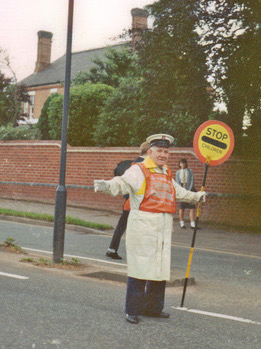
For seven years in the 1980s, James was the Crossings Officer for the pupils of the former Blackdown High School/Park Hall School/North Leamington School. He finished work about 8 months before he died, in October 1991. The school site is now a small private housing estate, and its allotment gardens and greenhouses long gone.
Mary Kelly
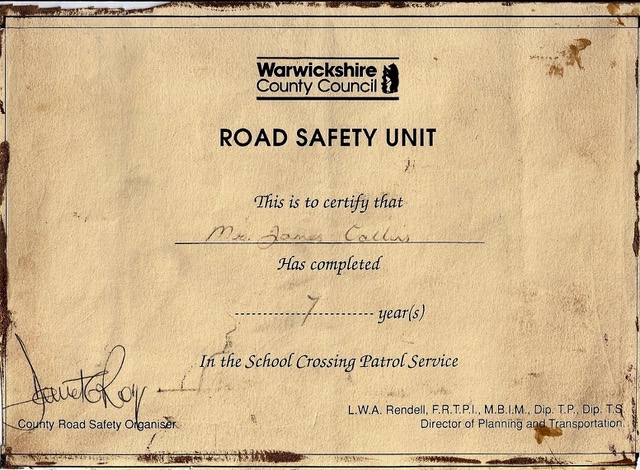
Next Door to the Miser’s Cottage
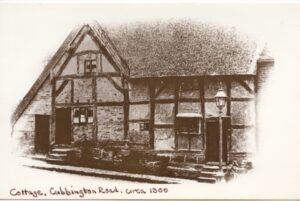
“Miser’s House” Cubbinfgton Rd (M Kalas)
Michael, elder son of Czech soldier Josef Kalaś, grew up in a house adjoining what everyone locally knew as The Miser’s House, number 90 Cubbington Road. An old thatched property dating to about 1600, when the population of the village numbered about sixty, for those who lived there its picturesque frontage sometimes left lots to be desired. Mike’s parents bought the house from his mother’s family, the Garretts, who also owned property in the centre of town.
Josef Kalaś and Joan Garrett met whilst Josef was billeted with a large contingent of Czech soldiers in Leamington during WW2, and married at the end of it, and although Joan tried hard to learn Czech, she struggled, and found it difficult to settle in Josef’s home country, so far from home and her extended family. They came back to where she felt most at home, first to 24 Chandos Street, then 7 Park Street, eventually buying 90 Cubbington Road from Joan’s brother in 1952. Their two sons and one daughter grew up there, and over time, saw a number of significant improvements to both house and garden, including selling a strip of the garden to the school for widening the school drive, and getting planning permission to build a garage. Mike has vivid memories of his bedroom under the steeply sloping roof, where apples from their garden were stored for the winter under his bed, – and eating his way through a lot of them!
By 1961, the house was under threat of demolition for road widening and improvements to access to Lillington School. Further improvements to the property were put on hold. As Joan said in an interview with The Morning News, “We are very loth to spend any more money until the future of the cottage is definitely decided.” Much to the family’s relief, in August that year a clamp-down on local government expenditure allowed a stay of execution. It was however only a stay, and when the cottages were demolished, the family moved to 82 Kinross Road, where Joan and Josef saw out the rest of their lives. Mike now lives in Dunblane Drive, not too far away from where he and his siblings grew up.
Michael Kalaś
Growing up in Milverton & Lillington Square
Dances in the Old School Hall
I was born in Milverton, Leamington Spa in 1944 and my first awareness of Lillington came with attendance at Lillington Junior School(1952-1955), where I moved from Milverton Infants. I was taken to and from school by school bus, which picked me up in Rugby Road.
On Cubbington Road near the entrance to Lillington Junior School there was a little shop owned by Dorothy and Rosa Lambert, who became our neighbour’s when my wife and I moved to Lillington in 1970.
I remember regularly walking from Milverton to Lillington in the mid to late 1950s, with my mother, to visit my uncle, aunt and cousin who lived in Briar Close. They had been moved there from Brook Street.
In 1959, my family moved from Milverton to Crown Way. My Grandad also moved up the hill from Milverton to a prefab on Gresham Avenue. I began to attend St Mary Magdalene’s and joined the Church Youth Club. They met on Sunday evenings in the hall of the old Lillington School on Cubbington Road. In 1961/2, they moved to the Community Centre on Mason Avenue. Local pop groups were sometimes hired – I have vivid memories of Woody Allen and The Challengers.
I used to go to square dancing about this time, back in the old school hall, where the caller was a well-known colourful local figure, Major Domoney. A generation later, in 1974, my son used to go to Cubs Meetings in the same hall.
In the 1970s, the Crown Way Post Office had an archway through to the shop next door, where they sold haberdashery items and knitting wool. It’s now an Indian take-away. The Crown Way Chemist’s was run by Mr Neale, who was a chemist and an optician used by most local families, including mine.
David Goulding
Lillington Stud and the French House Company
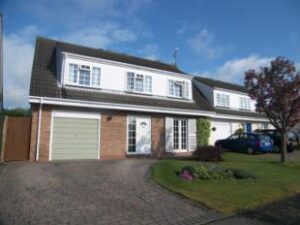
The French House Company who built some of the houses formed the English branch of a French company, La Maison Familiale, who were hoping to break into the English house building scene. In the later 1970s we had looked at the few houses they had completed in Monks Kirby and Marton, – the Chaumiere ( Cottage ) VIII design. Thirty eight French Houses were built on Lillington Stud land and all are either Camerica VII or Camerica VIII design. Both houses are of the same dimensions but the integral garage of the VII becomes a separate dining room in the VIII, with either a double or tandem garage built alongside.
All the houses have either one or two sets of French doors at the front of the property, and a further set at the rear. The original staircases had ‘lyre’ boards top and bottom, removable to enable bulky items of furniture to be carried upstairs.
In France, many houses are built of breeze blocks on raised plots, subsequently clad. As termites can be a significant problem, floors, including upper floors, are often made of concrete. Another ‘French’ feature is shutters.
Many of the Lillington Stud houses are built raised well above road level, and those of Camerica design are clad. The plots for England, are generous, and as a concession to the English mania for bricks, the Camerica VIIs are unclad at ground floor level. They also have functional shutters.
The steeply sloping roof timbers were constructed offsite and transported to the plots on low loaders. A crane then lifted the roof timbers down on to the waiting ground floor structures.
In Lillington the colour preference was for white rather than the creamier colour of the French Chaumiere, followed through in all the external paintwork, except the front doors which were stained wood.
As time elapsed, many of the original wooden features have been replaced by UPVC, and the curved ends of the roof a have also often been squared off, removing one of the houses’ most distinctive features. Most families have retained the shutters, often stripped and stained for ease of maintenance.
As a legal covenant forbids householders to build garden walls or grow boundary hedges over 18″/ 45 cm high, the estate has maintained its open feel.
On completion of Sandown Close, Redcar Close, Aintree Drive and a short section of Valley Road, vehicle access from Cubbington Road via Epsom Road was permanently closed and the pavement realigned, as agreed at an earlier date with Mr McGregor.
The difficult financial climate in Britain in the 1980s meant that the final few houses on Aintree Drive were not completed by the French House Company, who by that time were virtually bankrupt. Local builders Crosbee and Atkins bought the remaining strip of undeveloped land, and proceeded to built eight linked-detached homes in a totally different style, emphasising brickwork and dark woodwork.
Many of the original French Houses were taken by IBM employees, and by 1981 were fetching between £43,950 and £47,950, depending on size and position and fetch almost ten times that in 2016.
Although today Groupe Maison Familiale still build over a wide area in France, the English ‘arm’ ceased trading in Britain in 1982.
Dearne Jackson
Police House in Cromer Road
Initially we lived in rooms with Mrs Reeve at 32 Leicester Street, but I am not sure how long we lived there. Our next house was a rented police house at 32 George Street, and my local school was up along Radford Road at Clapham Terrace with Mr Baxter as headmaster. Eventually we moved to a new police house, one of a pair at 26 Cromer Road Lillington. We must have been there by the summer of 1952, as my name appears on the admissions register for Lillington Mixed and Infant School at that date. So it was that I was walked by my mother through the passage off Valley Road through to Cubbington Road for my first day on 8 September 1952. I was there a relatively short time as by 23 December 1953 I had left to be transferred to the recently built Lillington Junior School. I can’t remember much detail but two teachers’ names do come to mind: Miss Luggar and Miss Morgan and I think Mr Alan was headmaster.
We lived happily at 26 Cromer Road. The adjoining police house was occupied by Vic Sandel who I think was in CID whereas my dad was in uniform and on motor patrol. Dad worked a shift pattern which meant that sometimes he would have gone on ‘early turn’ before I got up, and sometimes on ‘lates’, he left before I went to bed.
Picture if you will Valley Road on the route of Midland Red buses L56, L57 and L58. Dad one day brought home a lice- and flea-ridden ginger tomcat. It was in a very bad state but thanks to the tender care of my mum he grew into a stunning long-haired specimen. Where is this leading? Sandy, as he was called, could be found on occasions washing himself as only cats do, in the middle of Valley Road. More than once, as Sandy remained unmoved by the red bus, we witnessed the driver leave his cab and place him safely on the grass verge out of harm’s way before driving on.
I recall a Coronation Party on wet day in June 1953 in the unmade road, getting our shoes stained by the red clay extracted for brick-making in the area. I was reminded recently that my father assisted in the road closure for that event.
I seem to remember playing up in the remnants of the clay pits at the back of Mason Avenue where frogs and newts could be found in the old pools. I clearly remember the off-licence at the Far end of Cromer Road next door to the allotments. It was here, parked in a gateway that I had one of my earliest sightings of a steam roller which then belonged to the Leamington Spa Corporation. Little did I know that this would lead to a lifelong obsession with steam!
Opposite Cromer Road was Valley Road, where a number of my school friends lived. There was a lad called Graham Sexton who went on to become a jockey, but who tragically later took his own life. Further up from the Pound Lane end was Peter Fairley, whose father Sydney was a sub-editor for the Coventry Evening Telegraph. Most days Sydney would cycle from Lillington to work, either on a bicycle or more often than not, on a tricycle. Just beyond the Fairleys lived Chris Coggins, whose father Charles was then Clerk to the South Warwickshire Water Board. He provided me with a reference for my first job in Birmingham, which set me on my forty-year career in local government.
Closer to home at 24 Cromer Road lived Bill Lawrence who drove road sweepers for the Royal Borough of Leamington Spa and occasionally at weekends he drove for Priory Coaches. Our back garden joined with 50 Taylor Avenue, the home of ‘Tom’ Payne who ran a cafe in Church Street and who provided teas, coffee, crisps and biscuits on a Saturday night for the Youth Club and Community Centre on Mason Avenue. My mum helped out in the cafe and on Saturday nights at the Youth Club.
Having passed the 11+ I left Lillington Junior School to go to Leamington College for Boys. I lived in Lillington until August 1960, when on my father’s promotion to Sergeant we moved to Stratford upon Avon, and I transferred to King Edward’s School.
I returned with my wife Janet to live in Lillington in 1975, after I had taken a post with the Royal Borough of Leamington Spa in 1973. The Borough disappeared in 1974 after the reorganisation of local government, but we have lived here ever since.
Peter Coulls
Growing up in Kenilworth Road
From Kenilworth Road it was often possible to hear Lillington church bells when conditions were right.
It used to be a common sight to see horses grazing in the field at the junction of Cubbington and Lillington Roads. The traffic roundabout now there used to be planted annually, but these days it is covered in mown grass, almost certainly for financial reasons.
Graham Cooper
My New Home at Burbury Close
Fish in the Bathroom
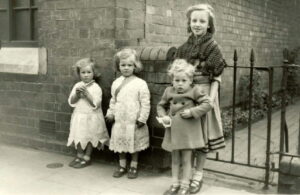
Until I was five years old I lived at 26 Oxford Street in Leamington Spa. I don’t remember anything about the house at all although I know that it was a terraced house next to a small grocer’s, confectioner’s and tobacconist’s shop that was run by a Mrs. H. Phillips. At No 21 was Gollins which was Clarendon Dairy. The house was rented by my grandad until my mum and dad married on 5th June 1943, when my dad took over the tenancy. I still have their old rent book which shows that the house was rented from Mr. Johnson who lived at 9 Rosefield Street. In 1959 the rent is shown as 20/- per week. My mum and dad had four children, all girls, and eventually there were six of us living there. This photo was taken in 1953 before I was born – it shows my three sisters, Marie, Linda and Carol and my cousin Alan Payne.
At Easter time in 1960 we were allocated a new, and it was new, house in Burbury Close Lillington. My dad arranged a van to take the furniture, but two of my sisters and I had to walk as there wasn’t room in the van. Walking up Leicester Street hill pushing my pink dolls pushchair with my sisters Linda and Marie is my first memory.
Marie was really excited about the new house as we had a bathroom, something we had never had before. It was decorated with white tiles and blue fish. It seems strange now to think that so much excitement could be had from just having a bathroom.
The house had four bedrooms, and as you might guess I was given the smallest bedroom, which was over the entry to the back gate and garden. There was no central heating and it was the coldest room in the house. To start with we had a coal fire in the living room which everyone would huddle around to keep warm. A short while later we had a two-bar electric heater, and then a Flavel Debonair gas fire was installed in the living room which was luxury, heat at the press of a button, and of course my dad no longer had to bring in the coal and make up the fire first thing in the morning or get rid of the ashes. Flavel’s started making the Debonair in August 1961 and it was very successful, if I remember correctly they had the contract to fit one in every council house in the area. On the top of the stairs we had a paraffin heater which wasn’t very good. It had a very distinctive smell and the paraffin had to be fetched from the garage or the hardware shop. I don’t have a photo of the house when we moved in – this one was taken on 17th April 1999, some years after we moved out and 39 years after we moved in. Satellite dishes weren’t around then and we had a green door.
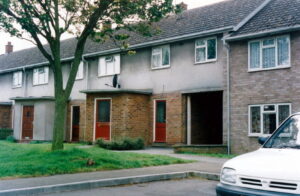
The garden was a good size with a shed at the far end, and dad used to grow peas, potatoes, cabbages, carrots – all sorts of vegetables. This would have been a big difference from Oxford Street where there was only a back yard, although I was too young to remember it. This photo of the four sisters was taken in the back garden around the time we moved in.
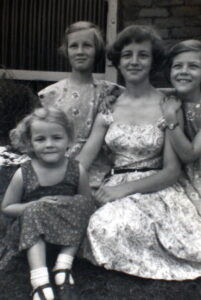
Following the Easter holidays it was time to start my new school. I attended Lillington Church of England Junior and Infant School, which later became Lillington County Junior School and can remember walking down Mason Avenue and then up the lane to school. Previously I had attended the old St. Paul’s Infant’s School – the entrance was in Cross Street.
I started at the school on 26th April 1960 and can remember Mrs Woodward and Miss Luggar in the Infant school and Mrs Reaves and Mrs Enoch in the Junior School. Miss Williams was Head of the Infants School and Mr Saunders was Head of the Juniors. At that time we all had a small bottle of milk each morning and when I was in the Juniors I was one of the milk monitors. Our desks had ink wells and we would write with ‘scratchy’ pens which would make a mess of our work if we weren’t careful – a good job there was blotting paper!
At the end of Burbury Close was a high brick wall close to a number of garages. The local children would climb over the wall as a short cut to Black Lane and the farm. We would often be playing around there.
Glynis Jennings (April 2016)
Cliffs, Hills, and Spud-Picking
School holidays then always seemed to be great. One of the things we did was to go potato picking, or as we called it, “Spud picking”. We used to wait at the end of Black Lane at about 7:30 in the morning, and one of the farm workers from Red House Farm came and picked us up on the tractor and trailer. There were about twenty of us piling into the trailer, clutching our sandwiches for our dinner. Mr Butlin owned the Red House Farm. He was quite a posh-talking gentleman whose mother owned the other farm on Newbold Comyn, which is now the golf club. Spud-picking was backbreaking work: no sooner had the tractor been round ploughing up the potatoes for us to pick up and put into sacks than it was round again. And so on, all day. At the end of the day, at about 4 o’clock, we went to the farmhouse where Mr Butlin paid us our wages for the day. Then it was back on the trailer along Black Lane and a weary walk home.
Another favourite pastime of ours was to go scrumping at Miss Newcombe’s. She had riding stables and an orchard and we used to climb over the wall into the orchard where she had apples, pears and all sorts of fruit trees. When we finally thought we had had enough apples, we took some home for our mothers to make apple pies.
Near to Miss Newcombe’s orchard was a large house, Newbold Beeches, built in 1861. It had been a 12-bedroom mansion situated between Newbold Comyn and Campion Hills, owned by a Mr Smythe. We used to explore the big garden out the back, where we found the graves of the family’s pets. The house was sold at auction in 1927, and became a training Centre and Cookery School for women and then the Ministry of Pensions office for social security. By 1973 it was in ruins and was finally demolished in 1975.
If we weren’t exploring The Cliffs, we were playing football and cricket with our mates on the Campion Hills, named after a 19th century farmer. When we played cricket, I don’t think any of us had a full set of wickets, bat or ball, but one of us usually managed to provide a bat, one a ball, and so on. We were happy.
In the summer holidays we used to pitch a tent on our front lawn. Tents weren’t so waterproof then and if you touched the side when it had been raining it immediately leaked on you! The only way to ease the situation was to painstakingly run your finger down the inside from every spot you touched so that the water would run down the inside of the tent and not on to you. About five or six of us would camp out. We usually took jam or cheese sandwiches and were okay until about 9 o’clock when it started to get colder, – then we all went home!
With spud-picking, working at the brickyard, blackberry-picking and scrumping, we had some great times. – I’m talking about the times when we were about thirteen or fourteen years old, when many of us used to do a paper round which also paid about 10 shillings for a whole week’s work.
Terry Wills
Lillington Pre-School Playgroup
Remembering “Mrs ‘All’s”

It had already been in existence for a few years when my daughter joined in 1974. The Play-group was run by a committee of volunteers and managed by Mrs Hall, with help from Mrs Looney and Mrs Duckett, and a rota of mums who took turns to hold a tearful child up to the window to wave to a departing parent. Little did the parent realise that once this little ritual was over, the child invariably scrambled straight down and pitched in to whatever activity was on offer, without a backward glance.
Playgroup was just that, – a place to play and learn through play, alongside other children. It was affiliated to the Pre-School Playgroups Association, whose motto (and we still have it, writ large on a kite, somewhere) was “Playing is Learning for Living”. Children had to be three years old and ‘clean and dry’ in order to start. They were free to choose an early morning activity, from painting, drawing, glueing, construction games, cars, dressing up, and sometimes, water play, using an old baby bath set on a plastic picnic cloth on the floor. Two grannies took turns to come and read with the children in the reading corner.

As children didn’t then start school until the term they were five, Mrs Hall, a former teacher, did some pre-reading, -writing and -number work with the rising fives, and then it was milk-and-biscuit time. While the chairs were set out in a circle and early activity equipment cleared away, a mum helper and either Mrs Duckett or Mrs Looney supervised toilet time and hand washing. Once milk time was finished, there was more playing, then Mrs Hall led singing and counting games, nursery rhymes and action songs, and then told a story, whilst helpers collected the morning’s art works and put them into their owners bags, ready to go home.
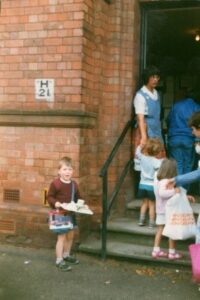
It was a busy morning, starting at 9am, when older siblings were at school, and finishing at 11.30. To begin with, Playgroup only opened on Tuesday and Thursday mornings, but as it became more popular, more days were added, and by the time our youngest son started in 1979, it was open every weekday, and a mother and toddler club opened on Tuesday afternoons, giving new mums the chance to get out and meet others with small children in an informal setting.
Mrs Hall (aka Mrs ‘All) became an institution in her own right, and a very difficult act to follow. Once she retired, and children began to start school at four, Playgroup changed character. It became Playdays Nursery School, with a different management structure, but to many who grew up in Lillington in the seventies and eighties, it will always be “Mrs ‘All’s.”
Margaret Rushton
Braemar Road 1954 – 1964
Like many of your correspondents, I briefly attended Lillington Infants School (and Pound Lane nursery before that, to which I think mother brought me over from the caravan on her bicycle), and then as soon as it opened, Telford School. I can remember having a holiday on the first day of term, as it wasn’t quite ready!
I also have fond memories of Sensicles, the old Post Office where the Walnut Tree was built, Keith Road, where we were frightened to go because someone caught polio there, Crown Way and the new library, the arrival of the L58 bus service, gas lights on Lonsdale Road, collecting wood for bonfire night, Planks the Bakers, the mobile fish and chip shop etc etc. Funnily enough I don’t think we ever knew anyone from the other, original, part of Braemar Road – presumably we newcomers didn’t mix!
My brother was born in 1955 and my sister in 1957, and we all grew up and had loads of friends in Lillington. My father helped build the original swimming pool at Telford.
As my parents always had a desire to live in ‘the country’, we moved to Claverdon in about 1964 (I remember because I had Harold Wilson posters all over my bedroom window at No 14 during the election!) and I’ve lost touch with everyone I knew – except for Andrew Laugharne, who lived on Leicester Lane. My brother and I did go back to Telford School three years ago (it was the 1000th anniversary of Warwick School, which we both got scholarships to, and we met Geoffrey Binks, ex Telford teacher and also an OW), which was fun. (April 2017)
Peter O’Brien
My Lillington
My earliest memory is a little later in my life so I would guess around the years 1976/77. I remember the two massive trees at the bottom of Compton Close (long gone now). I and others used to play in and around them. I also used to play marbles in the dried dirt at the base. I once recall falling off the wall close by and running home in tears with cuts, grazes and bumps. Those years in Compton Close are full of happy memories, – along with the two massive trees, the green in front of the houses is also gone, to provide parking for cars.
There were always some fun activities going on with the many children and young people who lived in the close, – the Timlins, O’Rourkes, O’Connells, Coopers, Halls, McLoughlins, and the Hunts. My sister Annie seemed always to be the organiser. We had running races, rin tin tin (or kick the can, – in fact it was a football), hide and seek and football are ones I can recall. There were also some other great families in the immediate area – the Barrys, Dorgans (Lillian, Queen of Lillington), Bloods, Stanbridges, Finns, Reynolds, Ruddlesdins and Collins to mention not a few.
I remember a fuss being made one day when there was a magpie on a roof top in the close. Apparently, this was a rare sight then, but isn’t any more. Other memories I have are of the Corona pop man coming round, and getting 10p for returning the glass bottle.
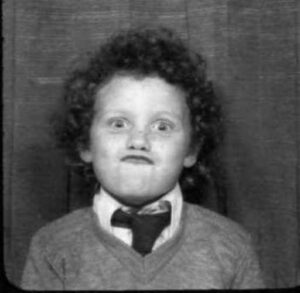
I attended Lillington Nursery next to Lillington Infant School. I recall playing on the blue plastic pedal tractors and having milk and fried bread. Later on when I joined the Infants, Mrs Enoch was the head and later Mrs Ann Lancaster, – “the Lancaster bomber.” I don’t think she knew of this nickname. I am very pleased to call Ann a friend now.
I went on to Lillington Middle School and represented the school at football and athletics getting to the county finals in the sprint relay at Edmondscote track. I was in the green of Greville, one of the four school houses. We finally won the school sports relay in the 4th year after trying the previous three years.
Some of the influential teaching staff for me were Mrs Smith, Mrs Burns, Mr Coope, Mr Simon Rogers and Mr Alan Franks who was the Head. He was a nice man, years later helping a group of local lads and men form an adult football team in which I played (Lillington FC) to use the school as our home pitch and redevelop the changing rooms to meet with league rules. The team was run by the late Anthony Smith and Tony Smith who was then caretaker of the school. Someone everyone loved at school was Mrs Edwina Hartley. Years later I became her neighbour in Crown Way and we became good friends.

Local celebrity wrestler Tony ‘Banger’ Walsh used to take my school year for football in the playground of the old school. Like so many local children, I attended Croft Hall, North Leamington School, after Lillington. I was fortunate enough to have some lovely teaching staff such as Neil Roach and John Williamson along with Lillian Dorgan running the school dinner canteen.
A memory I share to this day with my own family is the visit to Leamington of Diana, Princess of Wales. All North Leamington School were lined up along Lillington Road waving and cheering. For one split second in time, the Princess of Hearts looked me right in the eye as she passed by on July 8th 1989.
The many alleys in and around the estate were always good for exploring. Now they are gated for residents only to use. Further afield from Compton Close I remember the Jack and Jill pub (now houses), Mason Avenue Park beyond the tree line, a grassed area where many played football behind Winston Crescent (now Wackrill drive and Fell Close.) Going to Mason Avenue Park was easier then, one could walk through the spaces between the flats that were on Mason Avenue. (pictured) These were knocked down in the 80’s to make way for houses and maisonettes.
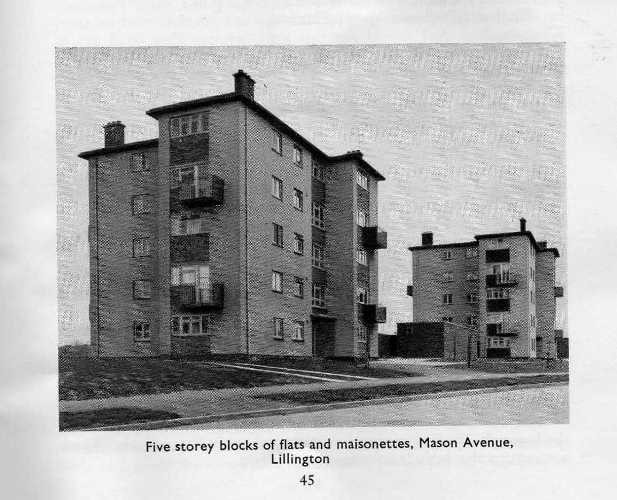
I remember playing on the large mounds of mud beyond Pound Lane and getting in trouble for getting my new trousers dirty, – I couldn’t sit down for an hour. This is now the Shuckburgh Grove area off Loxley Way, incorporating Acorn Court etc. Coincidentally my late father dug the footings out for all the buildings with his JCB digger when he worked for Warwickshire Plant Hire.
I also greatly enjoyed being an active member of Lillington Youth Centre with my school friends. The centre was always lively and fun; it gave one a sense of independence, responsibility and the confidence to explore the changing years to come. Those changing years have led me to become a Youth & Community worker at Lillington Youth Centre, where I have been based since December 1st 2008.
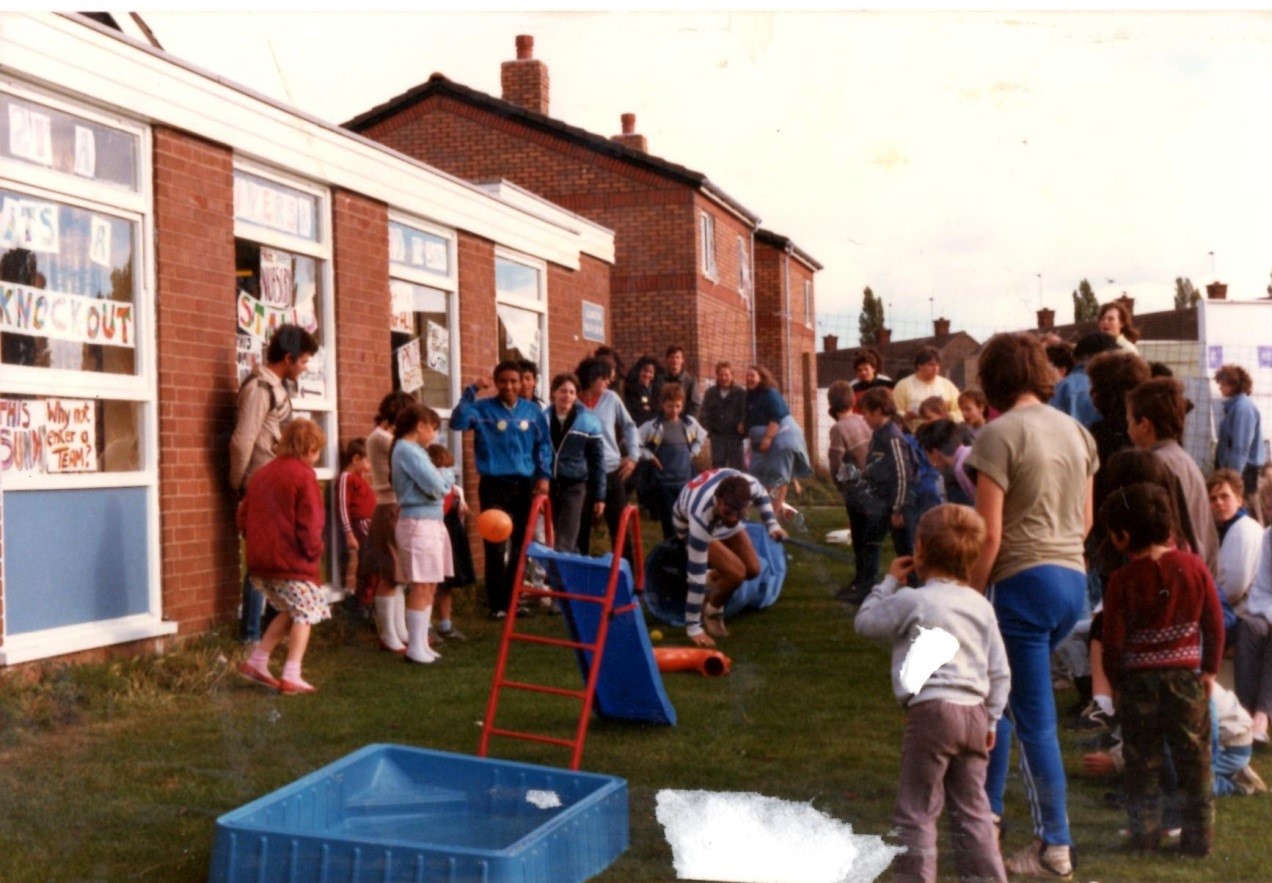
I absolutely love my job, I am very proud and privileged to support our Young People. I feel I can relate to local young people as I too have experienced what life is like growing up in Lillington. When I attended my older sister Annie and brother Steve were volunteers at the centre. I now manage a club that my own son attends and I dare say my daughter will too when she is old enough. We used to say “Are you going to ‘club’?”, but nowadays the young ones call it ‘Youthie’…. Whatever it’s called, it has supported local youth since 1965. Literally thousands of local young people have walked through its doors. I am blessed to do that most mornings.
Gary Timlin (April 2017.)
Lillington Prefabs

In 1947, before my youngest brother Stephen was born, my mother, father, elder brother Michael and I moved to Lillington to be housed in a “Prefab” at number 94 Gresham Avenue. We were told we would be there for ten years, – the expected ‘shelf-life’ of the buildings. The houses were all quite comfortable, with two bedrooms, a small (coal) fireplace, a kitchen with built-in units and a fridge, a bathroom, and good-sized gardens front and rear. The houses had electric ‘slot’ meters which took a shilling coin (5p), and if you ran out of shillings, you had no electricity. Sometimes my mother would say “Go and ask Mrs Crowe (our neighbour just across the road) if she has any shillings for the meter”. Mrs Crowe was quite deaf so you had to shout quite loudly at her.
Prefabricated sectional homes (Prefabs) were designed as a quick, easy and cheap solution to the shortage of homes after WW2, and locally prefab estates were built in Cubbington, Lillington and Whitnash. Many of the houses long outlasted their supposed ten-year life, – the 113 Lillington prefabs were not demolished until 1976 and 1977. These houses were built all over the country, in a variety of materials, including timber frames, pre-cast concrete and steel, and some had tin roofs. They were manufactured to predetermined standards, and Coventry-born Sir Frederick Gibberd, well-known now in Leamington for the Spa Centre, Kennedy Square and the Sydenham estate, was among the appointed designers, though not for Leamington local estates. The homes included innovations such as the back-boiler, to provide a constant supply of hot water and even central heating. The houses had to have a minimum floor area of 635 square feet, and each section had to be transportable by road. The kitchen and bathroom were installed back-to-back, so that all the pipework was in one place, easy to install, easy to maintain – and out of sight. The houses even came ready decorated, – cream painted walls with green glossed woodwork. For a family like ours, this accommodation was unheard-of luxury. My father was working on the railway, but later moved to the Ford Foundry and my mother had a part-time job at Lillington County Junior School, where we first went to school.
Among our neighbours in the prefabs were Fred and Rose Grazeley and their son John, at number 88. Fred worked at Pottertons’ in Warwick and Rose at Flavels’ in Leamington. I believe it was Rose who campaigned successfully for a bus route from the town up to Lillington. Next door to them at number 90 were Dennis and Margie Griffin and their son Nigel. Dennis was in the building trade before he moved to Massey Ferguson. Like a lot of families, the Griffins lived there for quite a few years, staying until the prefabs were demolished. At number 92 there was a grand old lady, my Great Auntie Liz, and her daughter Ethel. I remember taking rice puddings round to the house when Auntie Liz was unwell. Quite often if one of the neighbours had a bad cold or flu or a broken arm or leg it seemed that a rice pudding, tapioca or soup was the only remedy.
Next door to us at number 96 lived Mr & Mrs Clarkson. Mr Clarkson was a keen gardener. He had rows of potatoes all in a straight line. We never had to buy any. Dad was a keen gardener too, – he grew lettuce, delicious peas, cabbages, almost anything for the dinner table. A young couple lived at number 98, and he was a roundsman for Sensicles’, selling bread and cakes. In the last house on the right, number 100, was a family by the name of Owl. They were very quiet people. I don’t remember very much about them.
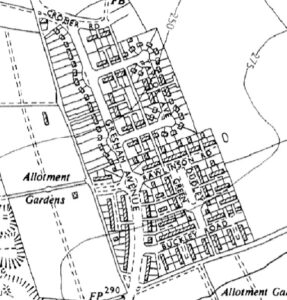
On our side of Gresham Avenue, down from the Grazeley’s house at no 88 was a short stretch of road with about six or seven more prefabs. It was called Gresham Place. I didn’t know many people who lived there but one family I do remember were the Shirleys.
At the top of the hill, between Buckley Road and the allotments was Black Lane, and in the opposite direction, Taylor Avenue with its neat semi-detached pre-war houses. Halfway down Gresham Avenue, where the prefabs started, there was a roundabout with two roads leading off, the one to the left was Gresham Place where we often played football, and the one to the right, Rawlinson Road, led to Dudley Green. We also played football on the green, and quite often the ball would end up in one of the residents’ gardens. Time for a sharp exit! I remember Mr Carter who lived in the Green, with his wife and two boys, Barry and Alan. Barry went into farming and Alan became an electrician and then a driving instructor. He taught many Lillington youngsters to drive, right up to the 1990s.
On the “odd” side of the Avenue, still in the prefabs, were the Hydes, then Bluey and Sadie Frost and their son, Trevor. Next to them lived the Joneses, Alf, Mabel and their children, Cheryl, Lesley and Chris. Alf had a Butcher’s shop in Clemens Street, – Alf Jones Butchers. I worked for him for quite a few years. When Alf died in the mid-1970s, and Chris took over the shop, I moved on.
Next door to Alf and family were Mr & Mrs Crowe and their children, Anita, Lanette and Raymond. Mr Crowe was an ambulance driver and a very keen gardener. His garden was full of shrubs, flowers and conifers.
At the other side of Buckley Road was Mrs Flowers’ house. She could get very cross if our football went in her garden. She would come out, pick the ball up and shout at us, – but then give the ball back. She had a lot to put up with. Her elder sister was bed-bound, so Mrs Flowers spent most of her time running around, fetching and carrying for her.
People who had had the luck to get a prefab looked after their house and their garden. They took pride in their vegetables, fruit trees and flowers. Many of them also had allotments, along Black Lane, or behind Gresham Place. In the 1950s, as people’s families got bigger and they needed more room, the estate expanded. New houses (not prefabs) sprang up in Haddon Road, Wellington Road, Clare Close, Compton Close. At the time I was growing up, we were a friendly sort of neighbourhood, all looking after each other.
Terry Wills
Memories of Lillington in the 1980s
1) The view across the Park to the Catholic Church of St Mary and the Mason Avenue flats was also to disappear between October 1981 and September 1983.

2) Autumn 1983 saw the destruction of an original field hedge along our side of the Park, when housebuilders Crosbie & Atkins purchased some extra land on our side of the Park in order to build eight Kline detached’ houses. A new hedge was planted along the bottom of their gardens and remains under council protection today.
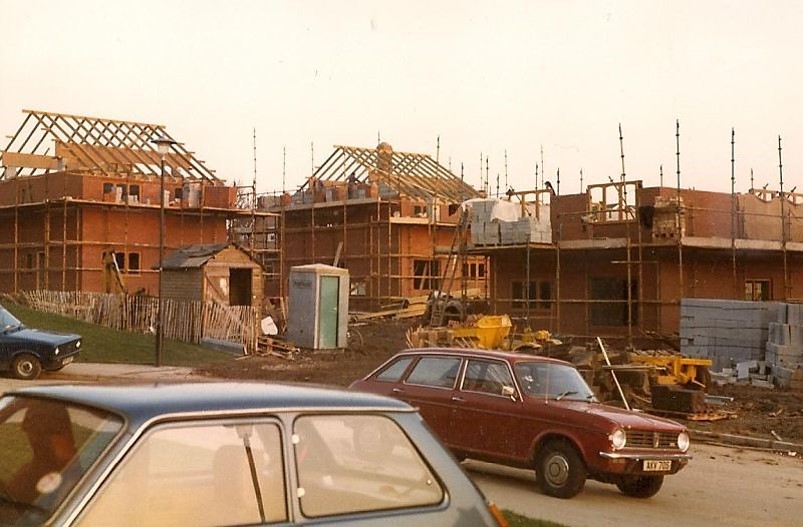
3) During the first half of the 1980s inhabitants of the Mason Avenue flats constantly complained that their homes were badly insulated, draughty, cold and damp. Fortunately, someone was listening! By September 1985 the flats were being demolished and replaced by houses.

4) Also in September 1985, came some further improvements , this time for young members of Lillington. new play equipment was installed on The Holt Park. Sadly, by the following year, someone had used the wooden structures as the basis of a bonfire, and what was left of this substantial play equipment had to be removed. Hopefully, the updated equipment installed in 2018 will not be vandalised.

5) October 1987 brought ‘The Great Storm’ to our county, but Lillington had had its own storm six months earlier, in March, when the block of flats opposite ‘Four Ways Care Home’ lost its roof in an overnight gale on 27th March.
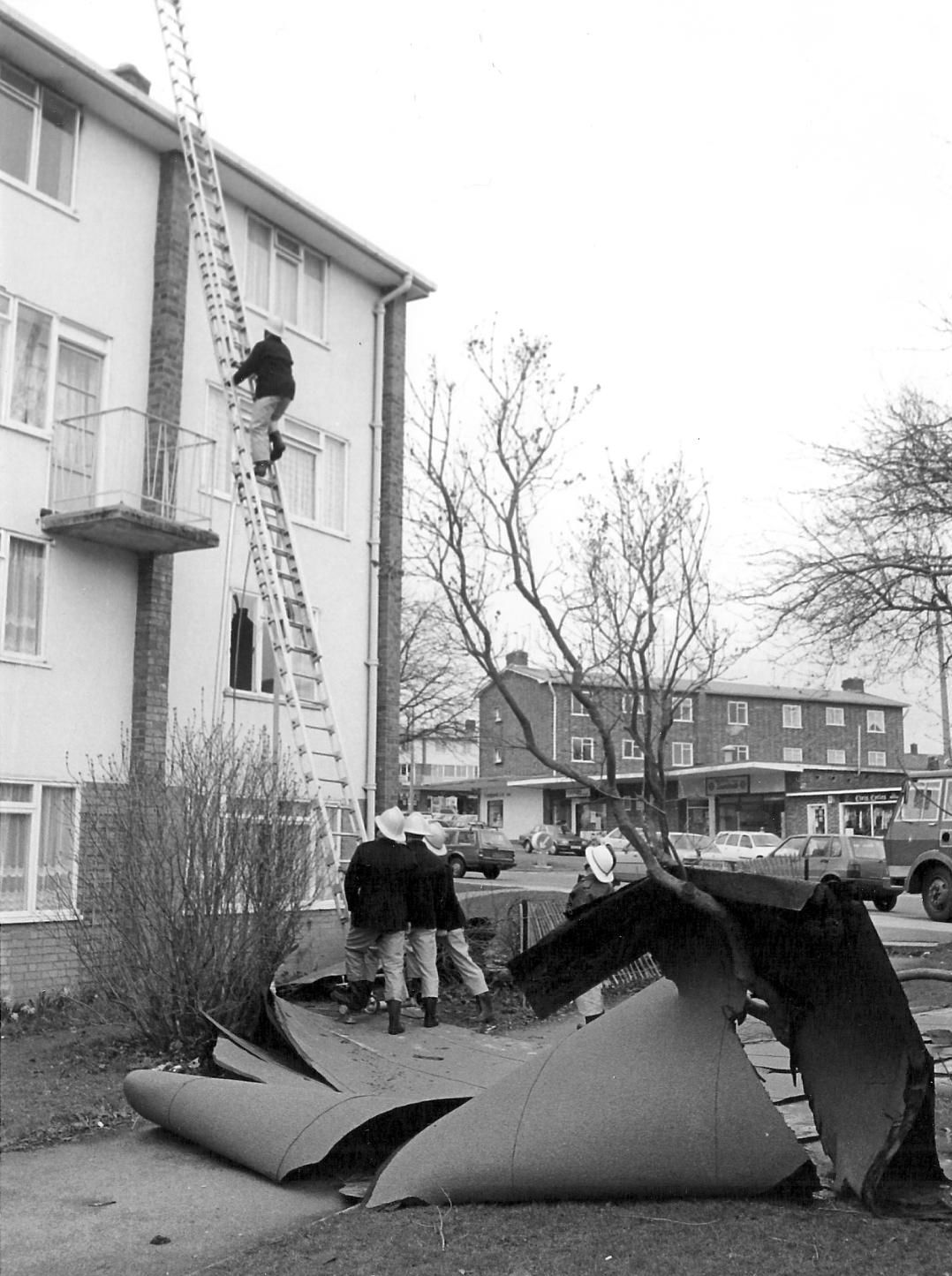
These are a few of the many small changes which have taken place, often barely noticed at the time, but which have become part of our ongoing history.
Dearne Jackson (May 2019.)
A Wonderful Place to Grow Up
Everything at Lillington is so close to my heart. It was a wonderful place to grow up, and in such an optimistic era. As some of your members have recalled Lillington Junior School was exceptional, with terrific teachers, such as Miss Lugger and Mrs Enoch, and its much-loved head, Mr Saunders. Mr Newton ran a science club, and Mr Pawley read us David Copperfield, bringing fearsome Mr Murdstone almost too-vividly to life.
Best of all the countryside was close at hand. My love of butterflies and moths began in the forest of docks and thistles and rosebay willowherb that grew on “the dumps”, the rough land on the right at the far end of Valley Road. Close by was the gorgeous modern library, all light and glass and wonderful books. We could find great crested newts in the little pond in the fields beyond, and perhaps spot a “woolly bear” garden tiger caterpillar crossing our path as we walked home clutching our library books. A huge book on The Prado, Madrid is etched in my mind – we could not resist those horrible but fascinating Hieronymus Bosch paintings. We wandered far and wide, mapped the ponds at The Cliffs (the old brick works), found toads down by the river where Newbold Comyn Country Park now is, collected badgers’ and foxes’ skulls at the sett on the hill beyond Red House Farm, and discovered crayfish where the Leam runs shallowly over stones opposite Offchurch Bury.
On summer evenings we enticed moths to a lamp at an upstairs window, and at dusk I waited in the garden for that snuffling, crashing sound in the hedge that meant a hedgehog was on its rounds. Northumberland Avenue was the place to collect conkers, and interesting boletus fungi – like the one Big Ears used for a house). One afternoon Michael and I brought home hundreds of conkers – some of which Mike had had to put down his trousers – we were wearing wellington boots so none escaped at the bottom. We left them in a pile and several sprouted. Several years later dad gave one to St Mary Magdalene Church, and a few years ago we saw what might have been a survivor on a google satellite view of our house.
I remember the excitement over the completion and consecration of Coventry Cathedral in 1962 and how a cross, made from some of the huge nails recovered from the bombed medieval cathedral was walked from parish to parish. We were with parishoners who accompanied it on its way up Cubbington Road to hand over to Cubbington one evening.
You have run a couple of articles on the old Manor Farm barns off Lime Avenue. My uncle Eddie Blackwell (married to my mother’s sister) owned Lime Garage whose offices were based in one of those barns.
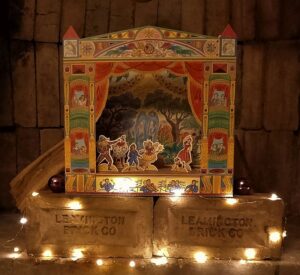
My father worked at Wickmans machine tool company at Banner Lane, Coventry, and when we were young he travelled to and from work by BSA Bantam motorbike. At that time the route was through Kenilworth and the state of the ford could be a worry, especially in winter, as it could flood quite seriously.
Though I have not lived in Lillington since July 1972 I often visit when staying with friends in Warwick. Sometime in the early 80s I think when I saw workmen demolishing a part of the Lillington Infants School site during its conversion to houses I begged two of the old bricks. The photograph shows them in use down here in Somerset.
One change that I feel is for the worse is the loss of the low brick pillars which used to be on either side of the Grange Road entrance to the junior school. Each carried a shield with the County Council coat of arms. This was not affectation but information, and as they mellowed with age were a kinder style than the severe sharp metal fence and gates of today.
Tina Rowe

